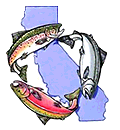A River Reborn: Restoration and Monitoring in the Former Footprint of Klamath Dams
Session Coordinators: Bob Pagliuco, Marine Habitat Resource Specialist, NOAA Fisheries Restoration Center; and Mike Belchik Sr. Water Policy Analyst, Yurok Tribe
The Klamath River once supported the third-largest salmon runs in the U.S. West Coast. Between 1918 and 1962, PacifiCorp built four hydroelectric dams—J.C. Boyle, Copco Nos. 1 & 2, and Iron Gate—that blocked migratory fish passage and degraded river ecosystems. After decades of advocacy by tribal nations and environmental groups, the Klamath Hydroelectric Settlement Agreement was reached, paving the way for dam removal. Physical removal began in mid-2023 and was completed in September, 2024. The removal of the Klamath River dams marks a historic step toward restoring one of the West Coast’s most important salmon runs, but success won't be measured in months—or even just a few years. Restoration and monitoring need to occur to understand the outcomes of this landscape scale project. This session will highlight the current and future restoration efforts in the footprints of the former reservoirs on the Klamath River and highlight what the first year of physical and biological monitoring has revealed thus far after the largest dam removal in history.
Klamath Dams and Downriver Nutrient Dynamics: Past, Present, and Future, John R. Oberholzer Dent, M.S., Biologist, Karuk Tribe Department of Natural Resources
Effects of Dam Removal on Klamath River Aquatic Food Webs, Claire Inouye, M.S. student, Cal Poly Humboldt Department of Environmental Science & Management
Occupancy Estimation from Juvenile Salmonid Summer Snorkel Surveys in Newly Accessible Klamath River Tributaries, Ben King, M.S., Biologist, California Department of Fish and Wildlife
Rebuilding Tributaries in the Former Reservoir Footprint to Support a Newly Free-Flowing Klamath River, Dan Chase, M.S. Biologist, Resource Environmental Solutions (RES), Dave Coffman, P.E., Resource Environmental Solutions
Beyond the Reservoir Footprint: Restoring Tributaries to the Klamath River After the World’s Largest Dam Removal Project, Max Ramos, M.S., Restoration Engineer, William Nuckoles, M.S., Restoration Engineer, Yurok Tribe Fisheries Department Technical Services Program
How Best to Remove a Fish Passage Barrier:, Blast or no Blast? A Case Study of the Jenny Creek Barrier Removal Implementation Determination, Evan Bulla, Project Manager, Trout Unlimited
The Klamath River Renewal Project Molecular Library, Describing Landscape-scale Aquatic Biodiversity Change Following Historic Dam-Removal and Restoration, Dylan J. Keel, M.S., Fisheries Ecologist, Resource Environmental Solutions (RES)
Monitoring Klamath Adult Salmon Abundance and Movement in Newly Available Habitat Post Dam Removal, Bob Pagliuco – Habitat Restoration Specialist, NOAA Restoration Center
Alex Corum -Biologist - Karuk Tribe
Repopulation of Chinook Salmon in Upper Klamath Lake and Its Major Tributaries, Jordan Ortega, Ph.D. Ecologist, Klamath Tribes
Modernizing Fisheries Data in the Klamath Basin: A Collaborative Leap Forward, Monica Diaz, Pacific States Marine Fisheries Commission
What Does Success Look Like? A Vision for Klamath River Salmon, Thomas Williams, PhD Ecologist, National Marine Fisheries Service, Southwest Fisheries Science Center, Santa Cruz Laboratory
Panel Discussion
